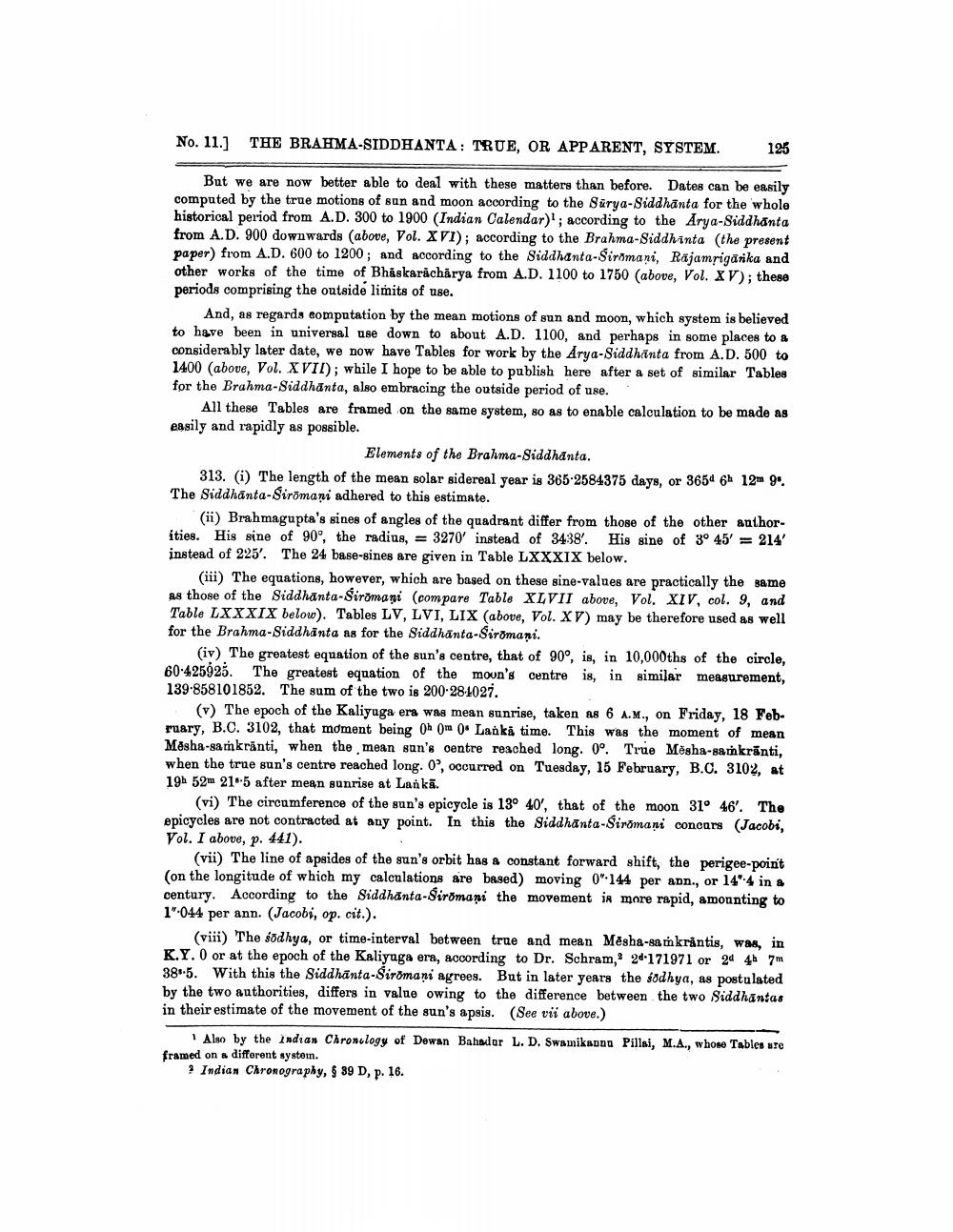________________
No. 11.) THE BRAHMA-SIDDHANTA: TRUE, OR APPARENT, SYSTEM.
125
But we are now better able to deal with these matters than before. Dates can be easily computed by the true motions of sun and moon according to the Sürya-Siddhānta for the whole historical period from A.D. 300 to 1900 (Indian Calendar); according to the Arya-Siddhanta from A.D. 900 downwards (above, Vol. XVI); according to the Brahma-Siddhinta (the present paper) from A.D. 600 to 1200; and according to the Siddhanta-Siromani, Rajamrigārika and other works of the time of Bhaskaracharya from A.D. 1100 to 1750 (above, Vol. XV); these periods comprising the outside limits of use.
And, as regards computation by the mean motions of sun and moon, which system is believed to have been in universal use down to about A.D. 1100, and perhaps in some places to & considerably later date, we now have Tables for work by the Arya-Siddhanta from A.D. 500 to 1400 (above, Vol. XVII); while I hope to be able to publish here after a set of similar Tables for the Brahma-Siddhanta, algo embracing the outside period of use.
All these Tables are framed on the same system, so as to enable calculation to be made as easily and rapidly as possible.
Elements of the Brahma-Siddhanta. 313. (i) The length of the mean solar sidereal year is 365-2584375 days, or 365d 6h 12m 9. The Siddhanta-Siromani adhered to this estimate.
(ii) Brahmagupta's sines of angles of the quadrant differ from those of the other anthorities. His sine of 90°, the radius, = 3270' instead of 3438. His sine of 3° 45' = 214' instead of 225'. The 24 base-sines are given in Table LXXXIX below.
(iii) The equations, however, which are based on these sine-values are practically the same as those of the Siddhanta-Siromani (compare Table XLVII above, Vol. XIV, col. 9, and Table LXXXIX below). Tables LV, LVI, LIX (above, Vol. XV) may be therefore used as well for the Brahma-Siddhänta as for the Siddhanta-Siromani.
(iv) The greatest equation of the sun's centre, that of 90°, is, in 10,000ths of the circle, 60-425925. The greatest equation of the moun's centre is, in similar measurement, 139-858101852. The sum of the two is 200-28-1027.
(v) The epoch of the Kaliyuga era was mean sunrise, taken as 6 A.M., on Friday, 18 February, B.C. 3102, that moment being Ohm 0 Lankä time. This was the moment of mean Mesha-samkranti, when the mean san's centre reached long. 0°. True Měsha-samkrānti, when the true sun's centre reached long. 0', occurred on Tuesday, 15 February, B.C. 3102, at 19h 52m 215 after mean sunrise at Lankā.
(vi) The circumference of the sun's epicycle is 13° 40', that of the moon 31° 46'. The epicycles are not contracted at any point. In this the Siddhanta-Siromani concurs (Jacobi, Vol. I above, p. 441).
(vii) The line of apsides of the sun's orbit has & constant forward shift, the perigee-point (on the longitude of which my calculations are based) moving 0° 144 per apn., or 14"-4 in a century. According to the Siddhanta-Siromani the movement in more rapid, amounting to 1".044 per ann. (Jacobi, op. cit.).
(viii) The sodhya, or time-interval between true and mean Mesha-sath kråntis, was, in K.Y. O or at the epoch of the Kaliyuga era, according to Dr. Schram, 24:171971 or 24 4 7 38-5. With this the Siddhanta-Siromani agrees. But in later years the sodhya, as postulated by the two authorities, differs in value owing to the difference between the two Siddhantas in their estimate of the movement of the sun's apsis. (See vii above.)
Also by the Indian Chronology of Dewan Bahador L. D. Swamikaona Pillai, M.A., whose Tables are framed on a difforent system.
? Indian Chronography, $ 89 D, p. 16.




